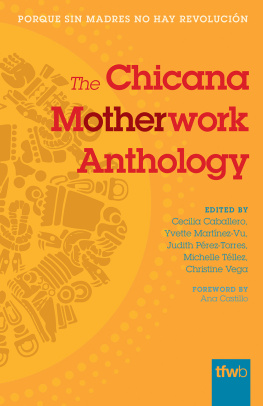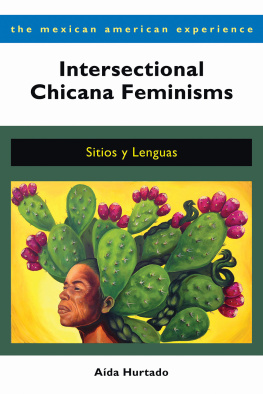NATIONAL WOMEN'S STUDIES ASSOCIATION / UNIVERSITY OF ILLINOIS FIRST BOOK PRIZE
A list of books in the series appears at the end of this book.
Ecological Borderlands
Body, Nature, and Spirit in Chicana Feminism
CHRISTINA HOLMES
2016 by the Board of Trustees of the University of Illinois
All rights reserved
Manufactured in the United States of America
1 2 3 4 5 C P 5 4 3 2 1

This book is printed on acid-free paper.
Library of Congress Cataloging-in-Publication Data
Names: Holmes, Christina, 1979 author.
Title: Ecological borderlands: body, nature, and spirit in Chicana feminism / Christina Holmes.
Description: Urbana : University of Illinois Press, [2016] | Series: NWSA/UIP first book prize | Includes bibliographical references and index.
Identifiers: LCCN 2016017322 (print) | LCCN 2016029803 (ebook) | ISBN 9780252040542 (hardback) | ISBN 9780252082016 (paper) | ISBN 9780252098987 (ebook)
Subjects: LCSH: EcofeminismMexican-American Border Region. | Mexican American women. | WomenMexican-American Border Region. | Women and the environmentMexican-American Border Region. | Environmental justiceMexican-American Border Region. | Feminism. | Mexican AmericansStudy and teaching. | BISAC: SOCIAL SCIENCE / Feminism & Feminist Theory. | SOCIAL SCIENCE / Ethnic Studies / Hispanic American Studies. | SOCIAL SCIENCE / Gender Studies.
Classification: LCC HQ1194 .H65 2016 (print) | LCC HQ1194 (ebook) | DDC 305.48/86872073dc23
LC record available at https://lccn.loc.gov/2016017322
To all who practice loving connection
List of Illustrations
1.Ana Tierra, Tree of Life
2.Juana Alicia, La Llorona's Sacred Waters
3.Juana Alicia, Mayan Scribe in The Spiral Word: El Codex Estnfor
4.Juana Alicia, El Futuro in The Spiral Word: El Codex Estnfor
5.Amalia Mesa-Bains, Venus Envy Chapter I
6.Amalia Mesa-Bains, The Virgin's Garden in Venus Envy Chapter II
7.Amalia Mesa-Bains, The Virgin's Closet in Venus Envy Chapter II
8.Amalia Mesa-Bains, Vestitureof Branches in Venus Envy Chapter III
9.Amalia Mesa-Bains, Cihuateotl (Woman of Cihuatlampa) in Venus Envy Chapter III
10.Amalia Mesa-Bains, Private Landscapes/Public Territories
11.Amalia Mesa-Bains, The Curandera's Botanica
National Women's Studies Association / University of Illinois First Book Prize
Sex Tourism in Bahia: Ambiguous Entanglements Erica Lorraine Williams
Ecological Borderlands: Body, Nature, and Spirit in Chicana Feminism Christina Holmes
The University of Illinois Press
is a founding member of the
Association of American University Presses.
____________________________________
University of Illinois Press
1325 South Oak Street
Champaign, IL 61820-6903
www.press.uillinois.edu
1. Ana Tierra, Tree of Life, watercolor painting donated to Women's Intercultural Center.
INTRODUCTION
Ecological Borderlands
Connecting Movements, Theories, Selves
With awe and wonder, you look around, recognizing the preciousness of the earth, the sanctity of every human being on the planet, the ultimate unity and interdependence of all beingssomos todos un paz. Love swells in your body and shoots out of your heart chakra, linking you to everyone/everything. This conocimiento motivates you to work actively to see that no harm comes to people, animals, oceanto take up spiritual activism and the work of healing. Te entregas a tu promesa to help your various cultures create new paradigms, new narratives.
Gloria Anzalda, now let us shift
The image that opens this book (products that include everything from hybrid cars to household cleansers. As popular and scholarly anxiety over environmental catastrophe grows, ecofeminism, the branch of feminist theory that is perhaps best poised to intervene, remains marginal among feminists and other academics. This is the case even as interest in new materialist and Anthropocene feminism ascends following the publication of volumes such as Stacy Alaimo and Susan Hekman's Material Feminisms (2008) and Diana Coole and Samantha Frost's New Materialisms (2010). Ecofeminist philosophy has fallen out of favor with feminists writing through the poststructural turn because of the perception that some scholars have simplified and essentialized the concepts of woman and nature. The too-easy dismissal of ecofeminist work forecloses important questions that ecofeminism raises regarding women's environmental activism and the gendered effects of environmental degradation. We need to consider how our relationships with each other and with the environment shape efforts toward justice or risk being left out of the conversation even as we challenge some of the shortcomings of ecofeminist theory production. A survey of the strategies employed by Chicana feminists and Mexican American writers, artists, and activists living and working in the border bioregions has much to offer ecofeminism and feminist theory. One of the aims of this book is to revitalize ecofeminist theory by investigating its intersections with other theoretical traditions, including Chicana and new materialist feminisms. To that end, Ecological Borderlands asks: What are the key debates in ecofeminism that need to be revisited in order for feminists to pay more serious attention to the ecological facets of justice? What characterizes the environmentalism that grows out of the conditions that shape Mexican American women's lives in the U.S. Southwest? How does this environmentalism challenge or rework the dominant characterization of ecofeminism?
In centering works by Chicana feminists and Mexican American activistssome who do and do not identify as ChicanasI do not mean to ascribe a unifying identity or presuppose any natural characteristics that bring together this particular group of women. Instead, I focus on Chicana studies as an emerging field with its roots in the political activism of the 1960s, including debates about identity, nationalism, and resistance that have evolved during six decades of scholarship and activism. From its inception, questions about just relationships among humans and between humans and the land took center stage; they were forged out of forced displacements and efforts to reconceptualize a politics of belonging in an era that continues to be marked by colonialism's legacy. The border region, including the diverse bioregions it encompasses, is a site of ecological activity and subject production; I borrow Anzalda's notion of the borderlands for this book's title precisely because this region creates an ecological borderlandsone marked by translocal and transnational flows of people, flora, and fauna, as well as by a multiplicity of economic, political, and cultural paradigms. Bioregions follow their own rules; because ecosystems may be shared across a national border yet differ within a single state, for example, activists have had to develop creative strategies and alliances (






 This book is printed on acid-free paper.
This book is printed on acid-free paper.